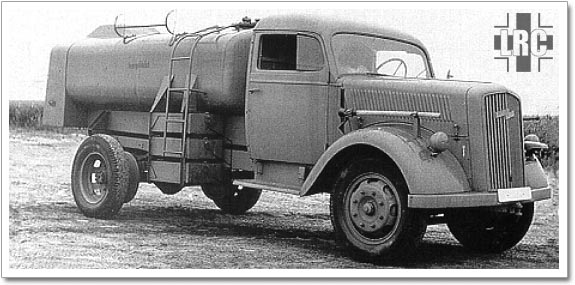LUFTWAFFE RESOURCE CENTER > PREVIOUS PAGE

Opel Blitz Fuel Truck.
[Source: Unknown]
A-Stoff - Liquid Oxygen
B-Stoff - Hydrazine Hydrate (Hydrazinhydrat)
Br-Stoff - Ligroin extracted from crude gasoline
C-Stoff - Catalyst (30% hydrazine hydrate, 57% methanol and 13% water) used by Walter R ii-211/HWK 509A rocket motor
K-Stoff - methyl chloroformate
M-Stoff - Methanol
N-Stoff - chlorine trifluoride
R-Stoff - Rocket fuel (known as TONKA 250) consisting of 57% crude oxide monoxylidene and 43% tri-ethylamine
S-Stoff - Rocket Fuel comprising 90-97% nitric acid and 3-10% sulphuric acid
SV Stoff - Rocket Fuel (known as Salbaei) consisting of 85-88% nitric acid and 12-15% sulphuric acid
T-Stoff - Rocket Fuel comprising 80% hydrogen peroxide plus oxyquinoline or phosphate as a stabilizer
Z-Stoff - Water solution of Na (Natrium) and Potassium Permanganate (kaliumpermaganat)
Aviation Gasoline
Grade A 3 - Light blue color. Rated at 80 octane.
Grade B 4 - Dark blue color. Rated at 87 octane.
Grade C 3 - Dark green color. Rated at 100 octane.
Other Fluids MW50
A 50/50 mixture of methanol and water (thus the name) that was sprayed into the supercharger of German aircraft engines primarily for its anti-detonant effect, allowing the use of increased boost pressures. Secondary effects were cooling of the engine and charge cooling. Higher boost was only effective at altitudes below the full throttle height, where the supercharger could still provide additional boost pressure that was otherwise wasted, while the smaller secondary effects were useful even above that altitude. MW 50 is something of a misnomer, as it is actually a mixture of three fluids; 50% methanol acting primarily to achieve optimum anti-detonant effect, secondarily as an anti-freeze, 49.5% water, and 0.5% Schutzöl 39, an oil-based anti-corrosion additive. The similar MW 30 increased the water to 69.5 and decreased methanol to 30%. This increased the cooling performance but made it easier to freeze, intended to be used for lower-altitude missions. The effect of MW 50 injection could be dramatic. Simply turning on the system allowed the engine to pull in more air due to the charge cooling effect, boosting performance by about 100 hp on the BMW 801. However the MW 50 also allowed the supercharger to be run at much higher boost levels as well, for a combined increase of 500 hp. At sea level this allowed the 1,600 hp engine to run at over 2,000 hp. MW 50 was fully effective up to about 6,000 m, above which it added only about 4% extra power, due largely to charge cooling. GM-1
GM-1 (Göring Mischung 1) was a system for injecting nitrous oxide into aircraft engines that was used by the Luftwaffe in World War II. This increased the amount of oxygen in the fuel mixture, and thereby improved high-altitude performance. GM-1 was used on a number of modifications of existing fighter designs in order to counter the increasing performance of Allied fighters at higher altitudes. GM-1 was developed in 1940 by Otto Lutz in order to improve high-altitude performance. It could be used by fighters, destroyers, bombers and reconnaissance aircraft, though its first use was in the Bf 109E/Z fighter. Originally, it was liquified under high pressure and stored in several high-pressure vessels until it was found that low-temperature liquefied nitrous oxide gave better performance due to improved charge cooling. It could also be stored and handled more conveniently and was less vulnerable to enemy fire. GM-1 was typically sprayed in liquid form directly into the supercharger intake from two jets of different bore while at the same time, the fuel flow was increased to take advantage of the additional oxygen from the nitrous oxide. The jets could be operated individually or in combination, yielding three steps of power increase, for example 120/240/360 HP at different GM-1 flow rates (60, 100 and 150 grams/sec). The development of a continuously variable injection system was considered, but apparently it never saw operational use. Initially intended as standard equipment for the Luftwaffe, in operational service it was found that GM-1 had some drawbacks. The additional weight of the equipment reduced performance on all missions, while the system was only used in the cases where the aircraft went to very high altitudes. GM-1 also became less attractive than originally imagined when in 1943, the previous trend towards ever increasing combat altitudes ended. While GM-1 saw little use in the second half of the war, the Focke-Wulf Ta 152H, which had been developed as a dedicated high-altitude interceptor, also received a GM-1 system to provide it with superior performance at high altitude. The Ta 152H was one of the few designs to support both GM-1 and MW 50.
Sources:
Gunston, Bill & Wood, Tony - Hitler's Luftwaffe
Wikipedia - MW 50
Wikipedia - GM-1
LUFTWAFFE RESOURCE CENTER > PREVIOUS PAGE
